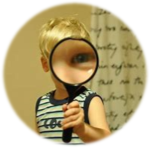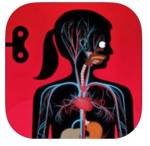 Are you out in the forest and want to look closer on something. Try to use an magnifying app on your Ipad. With eMagnifier can you even save photos from what you looked at.
Are you out in the forest and want to look closer on something. Try to use an magnifying app on your Ipad. With eMagnifier can you even save photos from what you looked at.
Kategori: English
Where am I?
Try to see if the children are able to locate themselves out of a picture. Try GeoGuesser that will present you a photo from GoogleMaps and the n you have to guess as close as possible.
Look Inside the Body
 With The Human Body app are you able to together look at the human body, hear the heart beat, the intestines gargle…
With The Human Body app are you able to together look at the human body, hear the heart beat, the intestines gargle…
There is also an additional manual to download for more in depth explanations.
Maps
Interesting ”to play with” is that you can get the app to ”fly over” a city and show how it looks. However, this only applies to larger cities.
If the children have been travelling, it can be fun to see where it is and how it looks.
Keep in mind that the time to go there says more than the distance in kilometers for the children.
Place the Skeleton in the Classroom
Then one can go really close to studying some detail of the body in depth.
Twinkl – English
 Twinkl is a site with a load of resources (all in english), sorted in age categories and by subjects. There you find lessonsplans and other material.
Twinkl is a site with a load of resources (all in english), sorted in age categories and by subjects. There you find lessonsplans and other material.
Are Things Too Slow?
Three apps to try are LapseIT, Osnap! eller iMotion.
The last one can also create stop-motion movies, i.e. put together individual pictures so that it becomes like a movie.
Tip: Try to put your iPad in the same place every day in a window and take a picture. If you put it together you get a picture of how the weather has changed throughout the school year!
